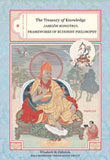
“In Part Three of Book Six, A Systematic Presentation of the Cause-Based Philosophical Vehicles, Jamgön Kongtrul presents an overview of the main aspects of the Hinayana and Mahayana systems (leaving out the Vajrayana segment of the Mahayana), and highlights the important points of their approaches. These are ‘cause-based yanas’ (rgyu’i theg pa), in contrast to the ‘result-based yanas’ (’bras bu’i theg pa), which is a common name for the Vajrayana. As Jamgön Kongtrul says, cause-based yanas employ ‘that by which we travel,’ a cryptic phrase meaning that these yanas use the causes of buddhahood as their path. Result-based paths use ‘where we are traveling to’ as their means; that is, their method is the result itself: the wisdoms and pure appearances of buddhahood. (Result-based approaches are treated in Part Four of Book Six, Systems of Buddhist Tantra.) Speaking generally, from a Hinayana perspective, the causes are the renunciation of samsara, the cultivation of ethical conduct, and the realization of the absence of a self of persons (pudgalanairatmya, gang zag gi bdag med). The Mahayana adds to that list the cultivation of the six paramitas and the realization of the absence of a self-entity of phenomena (dharmanairatmya, chos kyi bdag med).
These yanas are also called ‘philosophical’ (lakshasa, mtshan nyid). The term translated here as ‘philosophical’ in other contexts is translated as ‘characteristics,’ ‘defining characteristics,’ or ‘dialectics.’ In Chapter Five of this book, Jamgön Kongtrul states that the Paramitayana part of the Mahayana ‘is called a philosophical [yana] because it portrays (mtshon par byed pa) the path and its attributes that directly connect us to the unified state of Vajradhara, the final fruition.’ Thus the term refers to these yanas’ descriptions of the characteristics that make up the path. They do this by means of categorizations and definitions, analysis and reason, rather than faith and devotion. Here, the application of the term is broad since it covers the early Buddhist schools through Madhyamaka, including the Madhyamaka character of Secret Mantra.”
—Elizabeth Callahan, from the Introduction to The Treasury of Knowledge: Book VI, Part 3; Frameworks of Buddhist Philosophy, Jamgön Kongtrul


